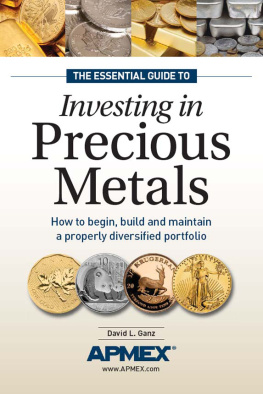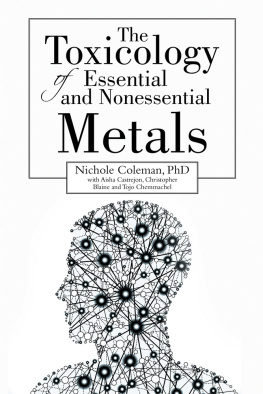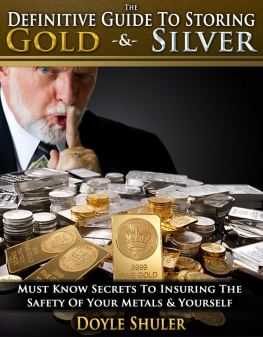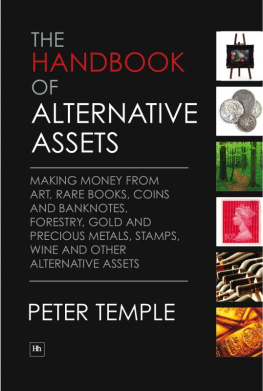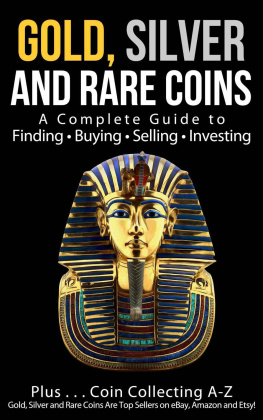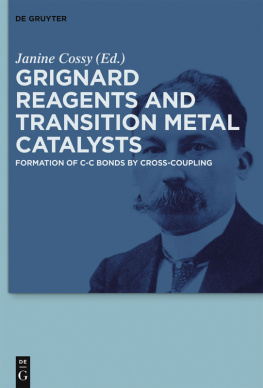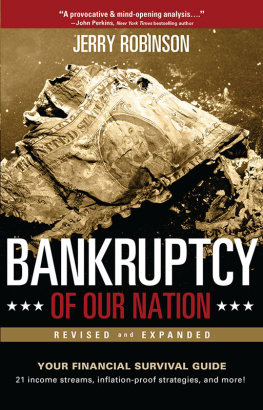Generally speaking, this book uses $1,500 as a rounded number when referring to gold and $35 to $45 an ounce when referring to silver. The market and the price of the precious metals are so volatile as to make it easier to use the generalized number than the specific. Where calculations are given, the actual numbers utilized are provided. Troy ounces are converted from grams on the ratio of 1:31.1035.
Foreword
My friend David Ganz has done what he does best in The Essential Guide to Investing in Precious Metals take a complex concept, synthesize it, illustrate it, analyze it and make it comprehensible to anyone needing information on the subject he addresses. He chose a propitious time for a book on precious metals, for as this goes to press, they are trading at levels reminiscent only of a short time in 1979 and 1980.
Through most of our lifetimes, we have witnessed a roller coaster ride for these commodities, but whether at the heights or the depths, they have always been the subject of an interest and fascination which far exceeded the number of people who traded in them. Why? Certainly not for their utilitarian value. Yes, palladium and platinum have important uses in a number of industrial applications including automobiles, electronics, medical and dental equipment and even drugs. Silver was long a staple of the photographic process and despite the emergence of the digital alternative, it remains the most widely used precious metal in areas as diverse as traditional ones like silverware and jewelry, or industrial ones such as electronics and high-tech parts and equipment, and even new age uses such as solar energy and water treatment. As for gold, entire books have been written on the unique properties making it suitable in so many diverse applications, from ocean deeps to outer space.

While interesting, none of this is why precious metals have captivated humanity, and why they have done so, especially in the case of gold, for nearly the entire expanse of recorded history. When the layman is asked to think of gold, his thoughts turn to jewelry and to the use most familiar to us, coins. As we say in the preface to Gold Coins of the World, it has been mans ultimate measure of economic value. For rarity, purity, luster, resistance to the elements and time, and for color and beauty, it has nary an equal. In times of trouble it has been a source of security when all else lay in ruin.
Palladium has only recently been used in coinage. Platinum has been used since the 19th century, and gold and silver, forever. The collector and investor of today, however, faces a different set of challenges than any of his predecessors. Precious metal coins are no longer used in circulation and their face value bears no relation to their metal content. They carry either a significant premium because of their collectors value, or, if they are mass-produced, a very small one. Nor do they have a role in backing monetary reserves or will never again.
This is a book to guide the reader through what can be a confusing and not well-marked minefield: Whether to buy bullion coins or collector coins? Legal tender ones or metal ingots? American or foreign? In small quantities or in bulk? And in what metal? The answer, of course, is one that only the reader can provide himself. How to methodically arrive at that answer is why this book is invaluable.
Arthur L. Friedberg
President, Coin & Currency Institute,
May 2011
About the Author
David L. Ganz (b. 1951) has traveled the world and had a multi-faceted career. He authored A Beginners Guide to Better Coins in 1965, the same year he started writing the monthly column Under the Glass for The Coin Shopper. He began writing a column with the same name for The Coin Collector, published by the Lawrence Brothers of Anamosa, IA., in 1967, the same year he joined the American Numismatic Association. By 1969, he moved the column to Numismatic News, changed its frequency and became the papers Washington Correspondent (1969-1973).
From that vantage point, he covered the battle in Congress to restore the right for Americans to own gold, witnessed the Hobby Protection Act creation, reported on the legislation that evolved into Americas bicentennial coins and other laws passed by Congress. A graduate of Georgetown Universitys School of Foreign Service with a B.S. in Foreign Service, he received his law degree from St. Johns University Law School in 1976. The following year, he wrote the seminal law review article Toward a Revision of the Minting & Coinage Laws of the United States which appeared in volume 26 of the Cleveland State Law Review 175-257 (1977), and was reprinted in its entirety in The Numismatist. Many of the suggested revisions have since been individually enacted by Congress.
He has written more than 30 books on a variety of subjects (from A [for A Critical Guide to Anthologies of African Literature] to Z [Zoning Law], and a number of coin books, recently including The Smithsonian Guide to Coin Collecting (2008), Profitable Coin Collecting (2008), Rare Coin Investing (2010), and Americas State Quarters (2008).
In 1974, President Nixon appointed him to the U.S. Assay Commission, and later that year, as a journalist, he testified before the House consumer affairs subcommittee on coinage matters, the first of more than a dozen times since that he has addressed Congress on gold, silver and other coinage matters. In the fall of 1974, he was invited on the Congressional inspection trip to Fort Knox, and is now one of the last standing who have visited and taken floor tours of all U.S. Mints and bullion depositories. Over the past quarter century, he has also been a contributing editor to

